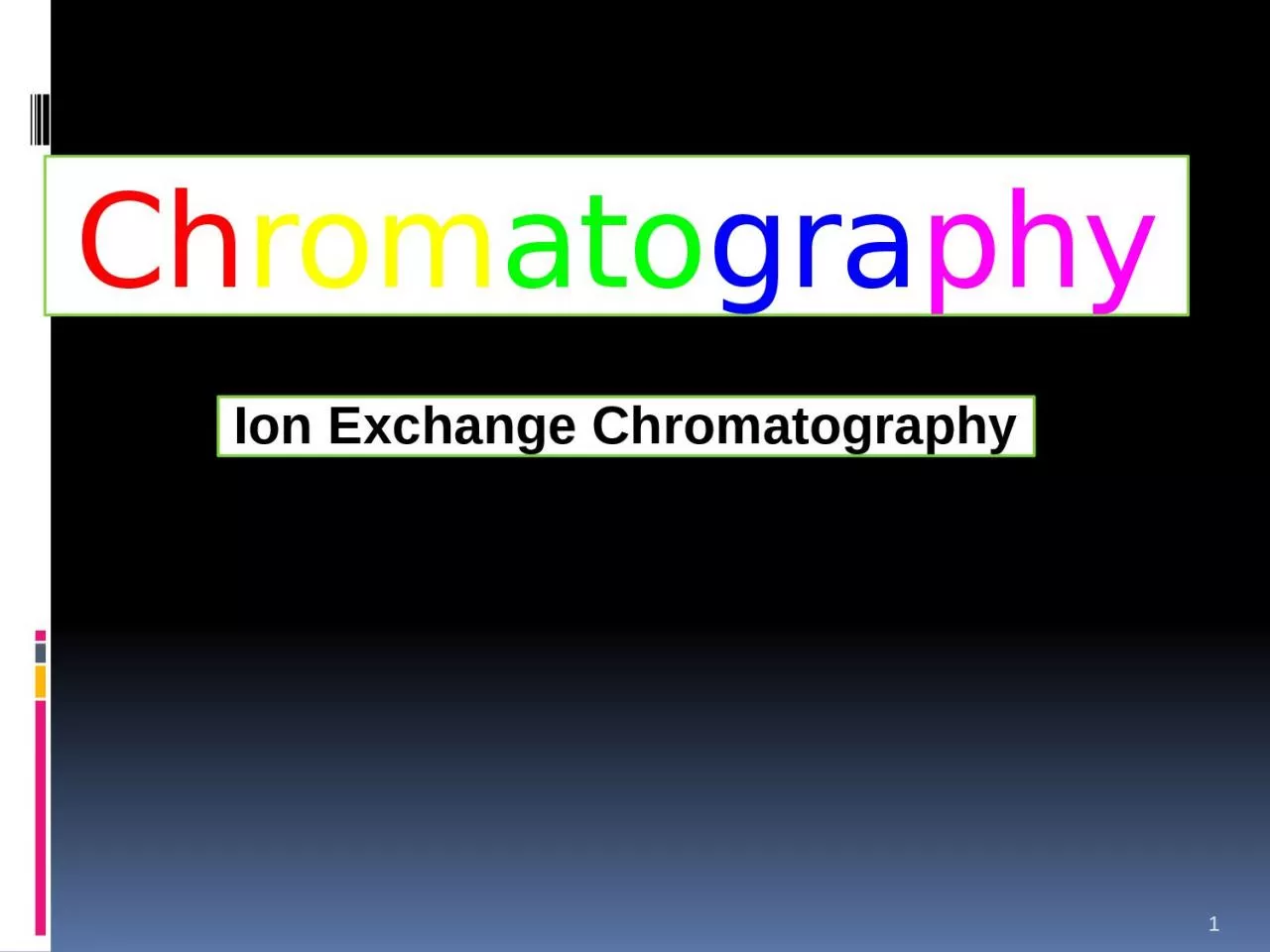

Definition Ionexchange chromatography or ion chromatography is a process that allows the separation of ions and polar molecules based on the charge properties of the molecules 1975 by Small Stevens and Baumann ID: 1025997
Download Presentation The PPT/PDF document "Ch rom ato gra phy 1 Ion Exchange Chroma..." is the property of its rightful owner. Permission is granted to download and print the materials on this web site for personal, non-commercial use only, and to display it on your personal computer provided you do not modify the materials and that you retain all copyright notices contained in the materials. By downloading content from our website, you accept the terms of this agreement.
1. Chromatography1Ion Exchange Chromatography
2. DefinitionIon-exchange chromatography (or ion chromatography) is a process that allows the separation of ions and polar molecules based on the charge properties of the molecules. 1975 by Small, Stevens and BaumannDr Gihan Gawish2
3. ion exchange chromatography is defined"In ion exchange chromatography separation is based on differences in the ion exchange affinities of the individual analytes. If inorganic ions are separated and can be detected by conductivity detectors or by indirect UV detection then this is also called ion chromatography"."Ion chromatography includes all rapid liquid chromatography separations of ions in columns coupled online with detection and quantification in a flow-through detector."Dr Gihan Gawish3
4. The following separation principles apply in ion chromatography:• ion exchange• ion pair formation• ion exclusionChromatography methods are defined by the chief separation mechanism used. Today ion exchange chromatography is simply known as ion chromatography (IC), while ion pair chromatography (IPC) and ion exclusion chromatography (IEC) are regarded as being more specialized applications.Dr Gihan Gawish4
5. Principles Behind Cation Exchange ChromatographyHow does it work?Ion-exchange chromatography revolves around the separation of molecules (ions, polar molecules, etc.) on the basis of a difference in chargeSpecifically, cation exchange chromatography is useful for the separation of positively charged species in solutionTwo phases:Stationary phase: consists of a resin or gel matrix of covalently bound negatively charged groupsMobile phase: composed of a buffered aqueous solution of counter-ions (positively charged molecules) that is in equilibrium with the total charge of the resin
6. The solution to be injected is usually called a sample, and the individually separated components are called analytes It can be used for almost any kind of charged molecule including large proteins, small nucleotides and amino acids. It is often used in protein purification, water analysis.6
7. Ion exchange chromatography retains analyte molecules based on ionic interactions. The stationary phase surface displays ionic functional groups (R-X) that interact with analyte ions of opposite charge. This type of chromatography is further subdivided into:cation exchange chromatography anion exchange chromatography. 7
8. Ion Exchangers8
9. Ion exchangers – Functional groupsAnion exchangerAminoethyl (AE-)Diethylaminoethyl (DEAE-)Quaternary aminoethyl (QAE-)Cation exchangerCarboxymethyl (CM-)PhosphoSulphopropyl (SP-)9
10. Cation exchange chromatographyCation exchange chromatography retains positively charged cations because the stationary phase displays a negatively charged functional group 10R-X C +M B R-X M + C + B-++-_++-
11. Anion exchange chromatographyAnion exchange chromatography retains anions using positively charged functional group:11R-X A +M B R-X B + M + A+_+-+-+-
12. A sample is introduced, either manually or with an autosampler, into a sample loop of known volume. The mobile phase (buffered aqueous solution) carries the sample from the loop onto a column that contains some form of stationary phase material. Stationary phase material is a resin or gel matrix consisting of agarose or cellulose beads with covalently bonded charged functional groups. 12
13. Ion-Exchange Chromatography SO3-Na+Separation in Ion-exchange Chromatography is based on the competition of different ionic compounds of the sample for the active sites on the ion-exchange resin (column-packing).
14. Mechanism of Ion-Exchange Chromatography of Amino AcidsSO3-SO3-Na+COO-H3N+Na+COOHH3N+pH2pH4.5Ion-exchange Resin
15. Ion-Exchange Chromatography – Separation based on charge
16. Schematic presentation of process of ion exchange separation16
17. Types of ion-exchange chromatography media
18. The target analytes (anions or cations) are retained on the stationary phase but can be eluted by increasing the concentration of a similarly charged species that will displace the analyte ions from the stationary phase. For example, in cation exchange chromatography, the positively charged analyte could be displaced by the addition of positively charged sodium ions. 18
19. ProcedureThe analytes of interest must then be detected by some means, typically by conductivity or UV/Visible light absorbance.A chromatography data system (CDS) is usually needed to control an IC. 19
20. Procedure20
21. Separating proteins Proteins have numerous functional groups that can have both positive and negative charges. Ion exchange chromatography separates proteins according to their net charge, which is dependent on the composition of the mobile phase. 21
22. Affect of pH in the separation of proteinsBy adjusting the pH or the ionic concentration of the mobile phase, various protein molecules can be separated. For example, if a protein has a net positive charge at pH 7, then it will bind to a column of negatively-charged beads, whereas a negatively charged protein would not. 22
23. Effect of pH in the separation of proteinsProteins are charged molecules. At specific pH, it can exist in anionic (-), cationic (+) or zwitterion (no net charge) stage.23cationicpH =pIanionicpH increase*pI isoelectric point
24. Choosing your ion-exchanger: knowyour proteinsStability of proteinsstable below pI value, use cation-exchangerstable above pI value, use anion-exchangerMolecular size of proteins<10,000 mw, use matrix of small pore size10,000-100,000 mw, use Sepharose equivalent grade24
25. Important to consider the stability of proteins in choice of ion exchangers. Isoelectric focusing can be used to identify suitable ion-exchanger type25
26. applicationsPolystyrene and polyphenolic IER: Seperation of small amino acids, peptides, nucleotides, N-bases,cyclic nucleotides, organic acids : intermediates of respiration, Cellulose IE: CM cellulose, DEAE cellulose, phosphocelluloseFor Proteins, enzymes, polysaccharides, nucleic acids, Polydextran and agarose: DEAE sephadex, CM, : Proteins, hormones, t-RNA, polysaccahraidesthe analysis of aliphatic carboxylic acids and their carboxylates salts in a wide variety of complex matrixes in environmental chemistry, food chemistry, biomedical research and pharmaceutical industries26